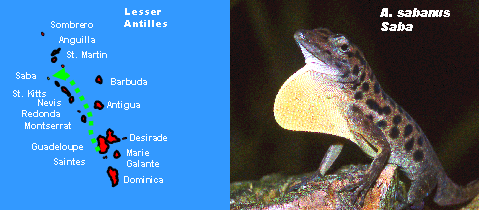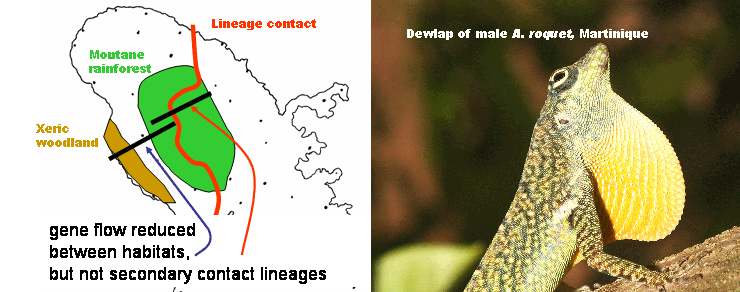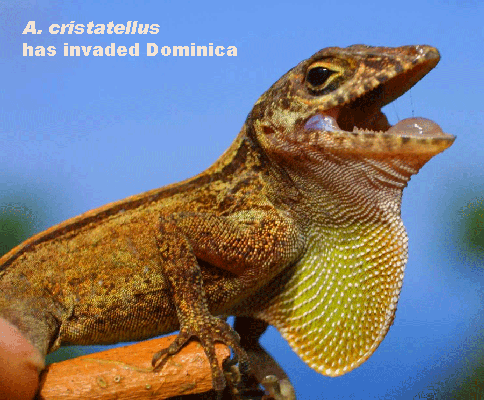
The Thorpe Group
Lesser Antilles lizards

As well as molecular phylogenetic studies of inter-island evolution in anoles and litter geckos the Lesser Antilles, we have focussed on within-island evolution, particularly factors influencing microevolution. This work has extended into population genetic studies of the factors influencing speciation and the role of ecological versus allopatric speciation.This work has been primarily funded by NERC and the BBSRC with support from the Leverhulme Trust.
Molecular phylogeny and phylogeography of the anoles and litter geckos has revealed new species, shown colonization sequence and revealed paraphyly of species For example, Anolis sabanus appears to have evolved when Saba was colonized from southwestern Basse Terre Guadeloupe (where it is phylogenetically nested within A. marmoratus) (Stenson 2004 MPE). And Anolis extremus appears to have evolved when Barbados was colonized from Martinique (where it is nested within A. roquet) (Thorpe et al 2005 Mol Ecol).
Colonization of Saba from SW Basse Terre Guadeloupe

Was the emergence of Barbados much earlier than geologists suggest?
The volcanic origin of islands and regions allows effective calibration of the molecular clock and there is close agreement between different clock methods and with expected ectotherm clock rates. However, molecular phylogeographic structure of the anole suggests the gradual uplifting of Barbados to emergence was very much earlier than geologists suggest (Thorpe et al 2005 Mol Ecol).
Natural Selection Studies and Field Experiments
Although molecular phylogeography shows deep lineages within islands, the distinctive geographic variation in quantitative traits within islands is linked closely to the latitudinal and altitudinal environmental zonation within mountainous islands (e.g., dry Caribbean coastal habitat versus wet, cool, montane rainforest habitat). This is shown by correlational studies that take into account phylogenetic relationships and by the parallel variation shown on different islands and in different lineages (Malhotra & Thorpe 2000 Evolution, Thorpe 2002 Syst Biol, Thorpe & Stenson 2003 Mol Ecol). Moreover, the pronounced geographic variation in quantitative traits is not due to environmental plasticity as is shown by common garden experiments (Thorpe et al 2005 Amer Nat), and replicated large-scale translocation experiments in the field show this to be natural selection acting rapidly on a wide range of target characters (Malhotra & Thorpe 1991 Nature, Thorpe & Malhotra 1992 Nature, 1996 Trans R Soc B, Thorpe et al Amer Nat 2005).

Spectrometry & Novel Methods To Analyse Spectrometry Data
Hue (e.g. of the dewlap- below) varies among populations, including in the human-invisible UV range, and novel methods have been developed to analyse spectrometric data in Thorpe (2002 Syst Biol).

Population Genetics and Speciation
Some islands (Martinique - above) are composed of several precursor islands that have been subsequently joined. The occurrence of secondary contact between populations from these precursor islands together with distinct habitat zonation enables us to critically test allopatric and ecological speciation models in anoles. Preliminary work (Ogden & Thorpe 2002 PNAS) suggests a role for ecological speciation, but ongoing work on this using SNPs and microsatellite markers will provide a more definitive answer (funded by BBSRC and EC).
Genetics Of Invasion
Dominica has recently been invaded by the Greater Antillean anole Anolis cristatellus from Puerto Rico. The genetics of invasion are currently under investigation with support from the Rufford Foundation and a competitive NERC
Case studentship supported by Wildlife DNA Serevices [Link to WDNAS].


